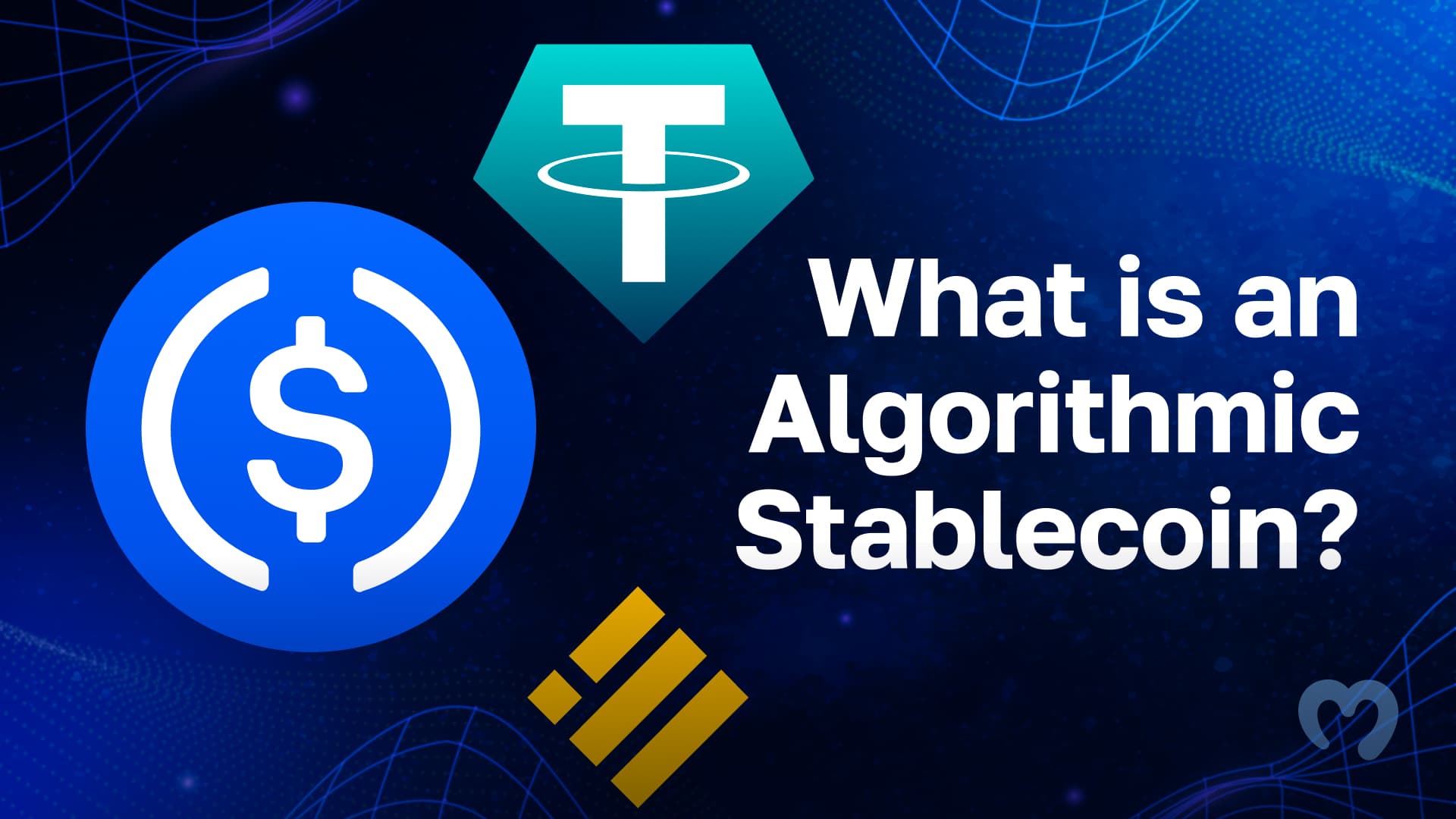Cryptocurrencies are highly volatile blockchain-based financial assets. The prices of cryptocurrencies can fluctuate dramatically in a short period, which is why stablecoins are essential tools for crypto investors. Stablecoins allow investor to mitigate crypto volatility by maintaining a value as close as possible to a fiat currency. Some of the leading algorithmic stablecoin projects include Dai (DAI), Frax (FRAX), and USDD (USDD). The US dollar is the most popular fiat currency, which stablecoins tend to mimic in value. Cryptocurrencies are far more volatile than any other assets, and it’s normal for a cryptocurrency to rise or fall in value by several percent within a few hours.
In this article, we’ll dive into the world of algorithmic stablecoin projects to find out how these relatively stable crypto assets work. Also, we’ll find out why stablecoins are essential for the crypto market. Furthermore, we’ll explore the working mechanisms behind algorithmic stablecoin projects and the key risks and benefits of these stablecoins.

Ethereum is one of the leading blockchain ecosystems for launching decentralized applications and crypto tokens. Learn the essentials of Ethereum at Moralis Academy.
What Are Stablecoins and Why Are They Important?
Stablecoins are an essential class of cryptocurrencies because they allow investors to withstand market volatility. Instead of dramatic price fluctuations, stablecoins tend to maintain their value as close as possible to a particular fiat currency. The leading stablecoins mimic the US dollar price, but some stablecoins refer to the Euro and other currencies.
Crypto holders can use stablecoins to avoid dramatic price falls in their crypto portfolios by converting a portion of their holdings into stablecoins. The price stability of stablecoins is precious during a crypto bear market when crypto prices sharply fall. Users can convert their crypto into stablecoins to save their profits and re-enter the market at a later, less turbulent moment. Furthermore, stablecoin yield farming allows users to earn an annual percentage yield (APY) through DeFi platforms. Numerous DeFi protocols enable crypto enthusiasts to deposit stablecoins and earn staking rewards over time.
With stablecoins, users don’t need to cash out crypto into fiat currency to save their profits. Investors can keep crypto in the form of stablecoins without fear of their assets losing value. Users have fiat-collateralized, crypto-collateralized, and algorithmic stablecoin projects at their disposal.
Find out more about the top stablecoins at Moralis Academy.
Fiat and Crypto-Collateralized Stablecoins
A portion of users regards fiat-collateralized stablecoins as the most reliable. These stablecoins have fiat currency backing each token at a 1-to-1 ratio. The companies that issue USD-collateralized stablecoins must keep one US dollar for each stablecoin unit in a designated bank account. Fiat-collateralized stablecoins have fiat currency backing at all times. The issuers of these stablecoins are subject to financial audits that ensure they have fiat currency backing.
Crypto-collateralized stablecoins use various other digital currencies as collateral. These projects can rely on other fiat-collateralized stablecoins or volatile cryptocurrencies for collateral. Volatile cryptocurrencies are prone to sudden and unpredictable price changes. Because of this unpredictability, crypto-collateralized stablecoin projects need to have more collateral than the combined value of each stablecoin. The crypto collateral serves to keep the peg of the stablecoin to the US dollar despite market volatility.

Blockchain technology is the moving force behind every crypto project. Learn the essentials of blockchain and crypto with the Blockchain and Bitcoin 101 course at Moralis Academy.
Algorithmic Stablecoins
Algorithmic stablecoins are arguably the most innovative class of stablecoins because of the technology underpinning them. However, there are many cases when algorithmic stablecoin projects have failed to maintain their fiat currency peg. Many users regard these stablecoins as less-stable assets, with a considerable degree of uncertainty about whether they’ll keep their peg efficiently.
Essentially, an algorithmic stablecoin uses a computer algorithm to control the supply of the stablecoin and maintain its peg to an underlying fiat currency. Some algorithmic stablecoin projects keep a cryptocurrency treasury with various crypto assets. These stablecoins are very similar to crypto-collateralized stablecoins because they use digital currency as partial or complete collateral. However, they also use an algorithm to regulate the supply and value of the stablecoin instead of having a team do this.
Other algorithmic stablecoins don’t use any crypto as collateral because they entirely rely on the computer algorithm to regulate the value of their coins. An algorithmic stablecoin is far more decentralized than classic, fiat-collateralized, centrally controlled stablecoins. Since the algorithm manages the stablecoin, no single authority can alter the coin’s supply and value.
An algorithmic stablecoin tends to perform various operations and implement pre-designed smart contracts to maintain its peg. Different algorithmic stablecoins use different mechanisms to achieve this. According to available data, algorithmic stablecoins are generally less capital efficient than centralized, fiat-collateralized stablecoins. Some of these projects struggle to maintain their fiat-currency peg and often fall slightly in price. However, thanks to the algorithm, these stablecoins tend to only fall in price briefly by a small amount. It’s pretty common to see a 0.999 USD value for algorithmic stablecoins.

How Does an Algorithmic Stablecoin Work?
There are various types of algorithmic stablecoins in terms of the operating mechanism they use. However, all algorithmic stablecoin projects use computer code and smart contracts to implement a specific algorithm that regulates the coin’s value. With fiat-collateralized and crypto-collateralized stablecoins, centralized entities control the supply and demand. The companies behind these projects regulate the value of the coins through collateral adjustment, crypto trading, and treasury management. Algorithmic stablecoins rely on smart contracts to implement pre-designed algorithmic rules. Because of this, some algorithmic stablecoins, like Fei USD (FEI), maintain a value close to one USD despite the lack of developers.
The computer algorithm monitors the supply and demand ratio in real time and regulates the value of the stablecoin according to the rise or fall of market demand. The algorithm attempts to maintain the coin’s value when the price falls. A popular mechanism involves selling portions of the crypto collateral or buying additional crypto to maintain the fiat currency peg. Some algorithmic stablecoins use liquidity pools on major decentralized crypto exchanges and DeFi protocols to ensure the stability of their collateral. Platforms like UniSwap and CurveFinance serve as valuable sources of liquidity for various stablecoins. Users get liquidity providing rewards for depositing crypto through these protocols and helping stablecoins like Dai and Frax stay stable.
Algorithmic stablecoins rely on automated, decentralized operational mechanisms, but this decentralization carries risks. The danger of algorithmic stablecoins is that the project can dramatically fail to maintain the fiat currency peg if the algorithm has flaws. There are various cases of algorithmic stablecoins entirely losing their peg, like Terra USD (UST) and Neutrino USD (USDN).

Learn the basics of crypto with the Crypto for Beginners course at Moralis Academy.
Algorithmic Stablecoin Operational Mechanisms
Algorithmic stablecoins use different operational mechanisms to maintain their fiat currency peg. All of these mechanisms are relatively new. Developers are experimenting with different types of algorithms to find the most efficient method for operating a decentralized, algorithmic stablecoin. However, most algorithmic stablecoins experience de-pegging from time to time, especially during highly-volatile market conditions and significant crypto sell-offs.
Algorithmic Stablecoins With Massive Crypto Collateral
One of the first algorithmic stablecoin mechanisms used significant crypto collateral to ensure the coin’s stability. The algorithm was designed to withstand price fluctuations during periods of market volatility. These stablecoins have much more crypto collateral than the value of their circulating supply. The crypto collateral usually consists of some of the leading cryptocurrencies like Bitcoin (BTC) and Ether (ETH). BTC and ETH are far more stable than some less popular cryptocurrencies. Overcollateralized stablecoins usually maintain a collateral level of at least 150% relative to their circulating supply.
Rebasing Algorithmic Stablecoins
A rebasing algorithmic stablecoin inflates and deflates the supply of the currency according to market conditions. These stablecoins have a fluctuating supply. The algorithm decreases the supply of the coins if the price starts dropping due to market volatility. When this occurs, the stablecoin becomes more scarce, and its value automatically increases to maintain the fiat currency peg. Likewise, if the coin’s price goes over the peg, the algorithm issues more coins to decrease the value and maintain the peg.
Seignorage-based Algorithmic Stablecoins
Seignorage-based algorithmic stablecoin projects use an operational model sharply different from the rebasing mechanism. Instead of inflating or deflating the coin’s supply with an algorithm, seignorage stablecoins use a dual cryptocurrency model. The system involves a stablecoin and a volatile cryptocurrency. The stablecoin’s value depends on the market performance of the volatile cryptocurrency, and the algorithm connects the two currencies. While the stablecoin has a fluctuating supply, the other currency acts as project shares. Holders of these shares mitigate the debt when the stablecoin falls in price. However, they also receive inflationary rewards for providing liquidity through redeemable bond tokens. The project encourages users to buy shares and receive rewards for depositing the shares into specific protocols.
Algorithmic Stablecoins With a Fractional Mechanism
Algorithmic stablecoin projects with a fractional mechanism are the newest type of stablecoins. These stablecoins combine partial crypto collateralization and a computer algorithm to maintain their value. Fractional stablecoins don’t use crypto over-collateralization. Instead, they have a crypto treasury which increases the collateral supply if the coin starts losing value. When the coin price goes over the peg, the algorithm decreases the collateral ratio to lower the coin’s price.
Crypto token launches and asset management can be simple and practical. The Moralis Token API allows you to manage token balances, transfers, prices, and more, in a streamlined and efficient manner.
Benefits of Algorithmic Stablecoins
Algorithmic stablecoins are highly beneficial for crypto users who want to secure their crypto profits without cashing out and converting their crypto into fiat currency. Cashing out crypto to a bank account has tax implications, can take a lot of time, and often incurs high fees. Also, when users want to reinvest fiat currency into crypto, they need to use the banking system once more and pay additional fees. Blockchain fees are usually far lower than bank fees, and users can easily convert their crypto to any leading algorithmic stablecoin through a crypto exchange. Additionally, various decentralized exchange platforms support algorithmic stablecoins. Users don’t need to incur high fees associated with many centralized exchanges.
Algorithmic stablecoins rely on decentralized operational mechanisms, meaning they are less prone to market manipulation in theory. However, there are also various risks associated with algorithmic stablecoins.
Fidelity Investments recently announced new crypto features and a plan to enter the metaverse. Find out all the details about Fidelity crypto investments at Moralis Academy.
Risks of Algorithmic Stablecoins
One of the critical risks associated with algorithmic stablecoins is that the whole project can go sideways if the algorithm malfunctions. The stablecoin can lose its peg, and investors can lose a considerable amount of assets. Stablecoins serve as a haven against crypto volatility. If a stablecoin loses its peg, the project fails to fulfill its purpose.
Most algorithmic stablecoin projects are relatively new. However, there’s already a list of algorithmic stablecoins that fully or partially lost their peg. A 0.999 or 0.998 USD stablecoin de-peg isn’t dramatic, but it indicates that the algorithm struggles to maintain the coin’s value. If this happens once in a while, it may not be a reason for concern, but if the stablecoin often has a value below its peg, it’s an issue. Fiat-collateralized stablecoins also lose their peg, but it’s far rarer than algorithmic projects.
Additionally, the algorithms behind these stablecoins are new, and the details of their smart contract mechanisms sometimes aren’t clear. Users don’t know if the algorithms have some backdoor that hackers could exploit to endanger the project. With fiat-collateralized stablecoins, the operational mechanism is often more transparent, although centralized.
The Crazy Snake Web3 snake game is one of the newest additions to the blockchain gaming scene. Learn more about Crazy Snake at Moralis Academy.
The Case of TerraClassicUSD (USTC) – Formerly TerraUSD (UST)
The case of the TerraClassicUSD (USTC), formerly TerraUSD (UST) algorithmic stablecoin, is one of the most infamous cases of stablecoin de-pegs. The UST stablecoin had an algorithmic tie to the Terra (LUNA) cryptocurrency. UST was a highly popular stablecoin and among the top 100 cryptocurrencies on the market. Terraform Labs, the team behind the project, had a multibillion-dollar BTC treasury to maintain the peg of UST.
However, the Terra ecosystem collapsed in the first half of 2022, leaving investors without approximately 60 billion USD of funds. In May 2022, two billion USD worth of UST left the Anchor Protocol DeFi platform. The liquidation of two billion UST created a massive liquidity crunch in the Terra ecosystem and caused a major crypto crash. Subsequently, the whole crypto market fell sharply, and millions of investors lost their money. The UST stablecoin de-pegged and is now trading at a fraction of a US dollar. The Terra algorithm failed to maintain the UST peg despite the massive Bitcoin treasury.
Learn all details about the UST and LUNA token crash at Moralis Academy.
What is an Algorithmic Stablecoin? – Summary
Algorithmic stablecoins play a vital role in the crypto ecosystem because they offer users a solution for combatting crypto volatility. Traders can use stablecoins to save their crypto profits in turbulent market conditions. Also, users can avoid cashing out crypto to fiat when using stablecoins. Algorithmic stablecoins use decentralized mechanisms to maintain their fiat currency peg. However, various risks are associated with algorithmic stablecoins, and cases like the UST meltdown show that these stablecoins aren’t always reliable. Users should be aware of the possible risks before investing in algorithmic stablecoins.
The bear market carries uncertainty and high crypto volatility. Learn how to invest during a crypto bear market at Moralis Academy.




